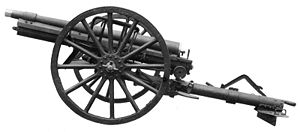Ordnance QF 15 pounder
| Ordnance QF 15 pounder Mk I | |
|---|---|

QF 15 pounder Mk I with standard British wooden wheels, original axle-tree seats and no shield
|
|
| Type | Light field gun |
| Place of origin | German Empire |
| Service history | |
| In service | 1901 - 1916 |
| Used by | United Kingdom |
| Wars | World War I |
| Production history | |
| Designer | Heinrich Ehrhardt |
| Manufacturer | Rheinische Metallwaren und Maschinenfabrik |
| Number built | 108 |
| Specifications | |
| Weight | Barrel & breech 737 lb (334 kg); Total 2,272 lb (1,031 kg) |
| Barrel length | Bore 7 ft 2 in (2.2 m); Total 7 ft 6 in (2.3 m) |
| Crew | 10 |
|
|
|
| Shell | Separate loading QF. Shrapnel, 14 lb (6.4 kg) |
| Calibre | 3 in (76 mm) |
| Breech | single motion, tapered block with interrupted collars |
| Recoil | hydro-spring, constant, 48 in (1.2 m) |
| Carriage | wheeled, pole trail |
| Elevation | -5° - 16° |
| Traverse | 3° L & R |
| Rate of fire | 20 rds/min |
| Muzzle velocity | 1,674 ft/s (510 m/s)? |
| Maximum firing range | 7,000 yd (6,400 m)? (percussion fuze) 6,600 yd (6,000 m) (time fuze) |
The Ordnance QF 15 pounder gun, commonly referred to as the Ehrhardt, was a modern German field gun purchased by Britain in 1900 as a stopgap measure to upgrade its field artillery to modern QF standards, while it developed its own alternative. This was precipitated by the experience of the British Army in South Africa during the Boer War, where its standard field gun, the BL 15 pounder, was out-performed by modern French and German field guns deployed by the Boers. It bore no relation to the BL 15 pounder or BLC 15 pounder, two other guns in British service at the time, other than a common shell.
The gun as originally designed and supplied to Britain had a sprung telescoping trail to assist with recoil control, all-steel wheels, axle-tree seats and no shield. The British found the trail unsatisfactory in service, so they permanently pinned it in the closed position. The British also immediately replaced the original all-steel wheels with standard British wooden spoked wheels.
It replaced the obsolete BL 12 pounder 6 cwt gun in Royal Horse Artillery service until the QF 13 pounder became available from 1904.
When the Territorial Force was formed in 1908 the guns were assigned to its cavalry units, known as Yeomanry. The axle-tree seats were removed as unnecessary because the gunners rode horses, and gun-shields were added. The modified carriage was designated Mk I+.
This gun is the "15 pounder" to which writers are referring in World War I if they are referring to RHA batteries of the Territorial Force, or Yeomanry. The other "15 pounder", the BLC 15 pounder, was an unrelated gun used by field artillery batteries of the Territorial Force, although it was also issued to some second line RHA batteries raised in 1914.
...
Wikipedia
